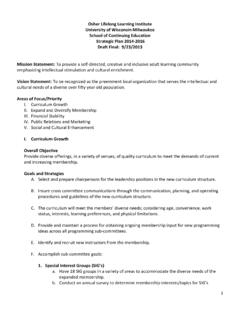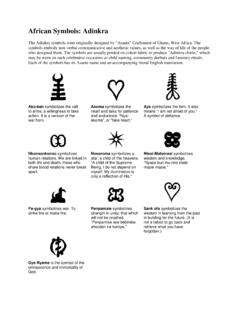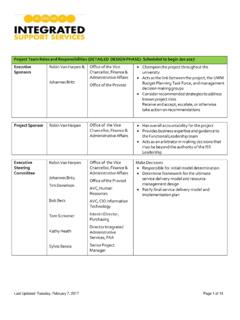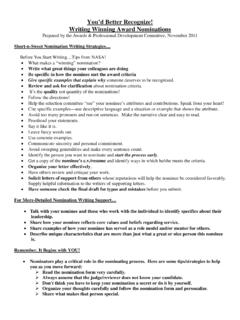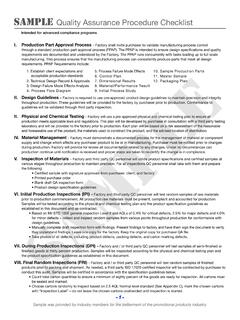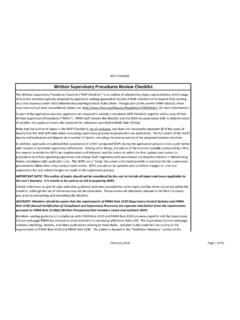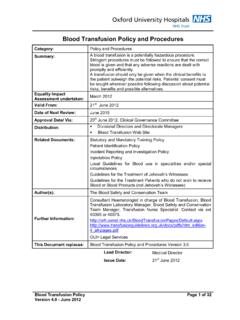Transcription of Lockout/Tagout Compliance Guide and Checklist
1 1 Lockout/Tagout Compliance Guide and Checklist Scope: The OSHA Control of Hazardous Energy ( Lockout/Tagout ) standard (29 CFR ) covers the servicing and maintenance of machines and equipment in which the unexpected energization or start up of the machines or equipment or release of stored energy could cause injury to employees. Energy sources may include: electrical, mechanical, hydraulic, pneumatic, chemical, nuclear, thermal or other energy. Application: This standard applies to the control of energy during servicing and/or maintenance of machines or equipment. Normal production operations are not covered by this standard.
2 Servicing and/or maintenance which takes place during normal production operations is covered by this standard if: 1. An employee is required to remove or bypass a guard or other safety device; or 2. An employee is required to place any part of his or her body into an area on a machine or piece of equipment where work is actually performed upon the material being processed (point of operation) or where an associated danger zone exists during a machine operating cycle. Applications not covered: Minor tool changes and adjustments which take place during normal production operations are not covered by the standard if they are routine, repetitive and integral to the use of the equipment for production, provided that the work is performed using alternative measure which provide effective protection.
3 Cord and plug connected electrical equipment when the employee performing the service or maintenance controls energization by unplugging the equipment from the energy source. Hot tap operations involving transmission systems from substances such as gas, steam, water or petroleum, when they are performed on pressurized pipelines. 2 Group Lockout/Tagout Procedure: If more than one authorized employee is required to lockout or tagout equipment, the following organizational procedures/structure shall be followed: 1. A primary authorized employee shall be designated to exercise primary responsibility for implementation and coordination of the Lockout/Tagout of hazardous energy sources and for the equipment to be serviced.
4 2. The primary authorized employee would coordinate with equipment operators before and after completion of servicing and maintenance operations that require Lockout/Tagout . 3. A verification system would be implemented to ensure the continued isolation and deenergization of hazardous energy sources during maintenance and servicing operations. 4. Each authorized employee will be assured of his/her right to verify individually that the hazardous energy has been isolated and/or deenergized. 5. When more than one crew, craft, department, etc. is involved, each separate group of servicing/maintenance personnel would be accounted for by a principal authorized employee from each group.
5 Note: The principal authorized employee is an authorized employee who oversees or leads a group of servicing or maintenance worker such as plumbers or electricians. Each principal authorized employee is responsible to the primary authorized employee for maintaining accountability of each worker in that specific group. No authorized employee may attach or remove another authorized person's lock/tag unless the provisions of the exception to 29 (e)(3) are met. The Lockout/Tagout process for each authorized employee shall include: 1. Each authorized employee shall place his/her own personal lockout device or tagout device on the energy isolating device(s).
6 2. When an energy isolating device cannot accept multiple locks or tags, a multiple lockout or tagout device (hasp) may be used. 3. If lockout is used, a single lock may be used to lockout the machine or equipment with the key being placed in a lockout box or cabinet which allows the use of multiple locks to secure the box or cabinet. 4. Each authorized employee will then use his/her own lock to secure the box or cabinet. 35. As each authorized employee no longer needs to maintain his/her lockout protection, that person will remove his/her lock from the box or cabinet and verifies or observes deenergization of the equipment.
7 Training: The employer shall provide training to ensure that the purpose and function of the energy control program are understood by employees and that the knowledge and skills required for the safe application, usage, and removal of the energy controls are acquired by employees. Each "authorized employee" shall receive training in the following: The recognition of applicable hazardous energy sources. The type and magnitude of the energy available in the workplace. The methods and means necessary for energy isolation and control. Each "affected employee" shall be instructed in the purpose and use of the energy control program.
8 All "other employees" whose work operations are or may be in an area where energy control procedures may be utilized, shall be instructed about the procedure, and about the prohibition relating to attempt to restart or reenergize machines or equipment which are locked out or tagged out. Retraining shall be provided for all authorized employees and affected employees whenever: There is a change in their job assignments. A change in machines, equipment or processes that present a new hazard. When there is a change in the employer's Lockout/Tagout program. Additional training shall also be conducted: Whenever a periodic inspection reveals noncompliance.
9 Whenever the employer has reason to believe that there are deviations from or inadequacies in the employee s knowledge or use of the energy control procedures. 4 The employer shall certify that employee training has been accomplished and is being kept up to date. When a tagout system is used, the employees shall also be trained in the limitations of tags. Definitions: Affected Employee - an employee whose job requires him/her to operate or use a machine/equipment on which servicing or maintenance is being performed under lockout or tagout . Authorized Employee - an employee who locks out or tags out machines or equipment in order to perform servicing or maintenance on that machine or equipment.
10 Energy Isolating Device - a mechanical device that physically prevents the transmission or release of energy. Manually operated disconnect switches, line valves, blocks and slide gates are examples of energy control devices that provide visible indication of the position of the device. On/off buttons, selector switches and other control circuit devices are not energy control devices. Energy Sources - any electrical, mechanical, hydraulic, pneumatic, chemical, nuclear, thermal or other energy. lockout - The placement of a lockout device on an energy isolating device, in accordance with an established procedure, ensuring that the energy isolating device and the equipment being controlled cannot be operated until the lockout device is removed.


